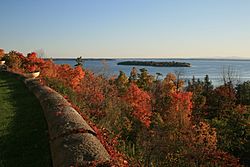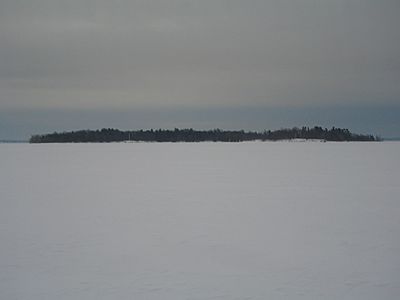Crab Island (Lake Champlain) facts for kids

View of Crab Island from Plattsburgh, New York.
|
|
|
Location of Crab Island in New York State
|
|
| Geography | |
|---|---|
| Location | Lake Champlain |
| Coordinates | 44°39′43″N 73°25′01″W / 44.662°N 73.417°W |
| Area | 40 acres (16 ha) |
| Highest elevation | 112 ft (34.1 m) |
| Administration | |
| State | New York |
| County | Clinton |
| Town | Plattsburgh |
Crab Island is a small island in Lake Champlain, near Plattsburgh, New York. It's about 40 acres (16 hectares) in size. This island is famous for its role in the War of 1812.
During the war, Crab Island was used as a special hospital for injured soldiers. Both British and American soldiers were treated there. It is also the site of a mass grave. This grave is believed to hold the remains of about 150 soldiers who died during the Battle of Plattsburgh.
The island is well-known locally for having a lot of poison ivy. Its name might come from the many "crabs" found on its shores. These "crabs" are actually fossilized shells and ancient creatures like trilobites.
Contents
Crab Island's War Story
Crab Island played a very important part in the Battle of Plattsburgh on September 11, 1814. On that morning, the small island marked the southern end of the American battle line.
Commodore Thomas Macdonough was the American naval commander. He lined up his ships between Crab Island and Cumberland Head, New York to the north. This created a strong defense across the entrance to Plattsburgh Bay. Macdonough's plan was clever. He wanted to force the British ships to fight his anchored fleet right away. This would give the Americans an advantage. If the British tried to sail around Crab Island, they would come under fire from American forts on the shore.
To help with this plan, Americans placed two cannons on the northern tip of Crab Island. Soldiers who were recovering from injuries, but couldn't fight, manned these guns. During the battle, a British ship called H.M.S. Finch got stuck on a reef near the island. It then had a fierce cannon fight with the Crab Island battery. The British commander later said his crew "killed or wounded every man at the guns on shore."
The Island Hospital
A military hospital was set up on Crab Island around September 6, 1814. This was just before the Battle of Plattsburgh. The hospital was made of simple tents and some quickly built log structures.
Soldiers who were too sick or injured to fight were moved to the island. This kept them safe from the fighting on the mainland. Many of these soldiers were later taken by boat to a bigger hospital in Burlington, Vermont. Doctor James Mann, a U.S. Army surgeon, was in charge of the island hospital. At one point, there were 720 sick or injured men there.
After the naval battle, Crab Island became the closest land for the wounded. The hospital took in injured soldiers from both the American and British fleets. About 150 soldiers died on the island or had their bodies wash ashore. They were buried close together in three long trenches south of the hospital. Officers who died in the battle were given proper military burials in Plattsburgh. But the regular soldiers were left in the mass graves on the island.
Crab Island is thought to be one of the only places where British and American soldiers were buried together. The exact spot of these graves has never been marked or found. However, the names of 91 of the deceased soldiers are known.
After the War
For many years, people in Plattsburgh worked hard to get a memorial built on the island. In the early 1900s, the United States Congress finally provided money for it.
In 1903, a 100-foot (30-meter) iron flagpole was put up. It was designed to look like a ship's mast. Then, in 1908, a 50-foot (15-meter) granite monument was built. This monument, called the Crab Island Soldiers and Sailors Monument, has bronze plaques on its sides. Paths were cleared for visitors, and a dock was built for boats. A full-time caretaker even lived in a small house on the island. In 1909, Congress officially renamed the island Macdonough National Military Park.
By 1930, the island was mostly empty. The caretaker left in 1915, and the caretaker's house burned down in 1929. The island stayed quiet until the 1950s. At that time, the United States Air Force tried to turn parts of the island into a recreation area for their nearby base. But this effort didn't last long.
In 1967, the government sold the island. This happened even though it had graves, monuments, and was a National Military Cemetery. Crab Island was bought and sold by private owners several times. It was saved from being developed thanks to a few dedicated people. They worked to change the island's zoning rules, protecting its historical importance.
Crab Island State Park
| Crab Island State Park | |
|---|---|
| Type | State park (Undeveloped) |
| Location | Crab Island, Lake Champlain |
| Nearest city | Plattsburgh, New York |
| Area | 40 acres (0.16 km2) |
| Created | 1988 |
| Operated by | New York State Office of Parks, Recreation and Historic Preservation |
In 1988, the New York State Office of Parks, Recreation and Historic Preservation bought Crab Island. They created Crab Island State Park to stop private companies from developing the land for fun activities.
The state first tried to buy the island in 1986. However, a businessman named Roger Jakubowski bought it instead. He wanted to make the island a place for boat tours, picnics, barbecues, and camping.
Many people felt these plans would harm the island's history and culture. Public outcry led New York State to use a process called eminent domain. This allowed the state to take ownership of the island in January 1988. The state paid Jakubowski $210,000 for the island. This was $20,000 more than he had paid two years earlier. Jakubowski later sued New York State for damages, but the case was settled in 1994.
New York State does not plan to develop Crab Island State Park. However, volunteers have worked hard to restore the island's monuments and paths. In August 2003, a group of volunteers fixed and put back the island's unique iron flagpole. It had fallen down in a windstorm in 1996. A bronze plaque at the base of the flagpole lists the names of the American soldiers buried on the island.



